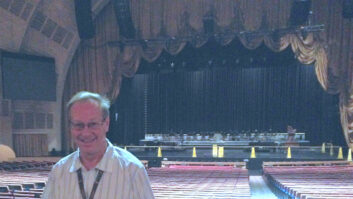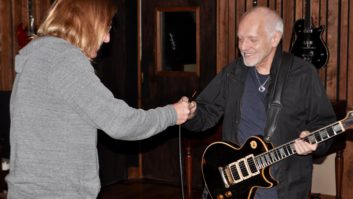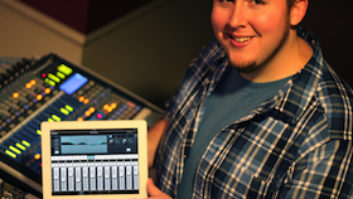In the ’80s, sound designers for Broadway musicals were among the first to use large numbers of wireless microphone systems in live performance. Today, the technology has been widely adopted for industrial, concert and TV applications. These days, it’s rare to find a touring band who does not carry at least one handheld wireless mic system, while large-scale broadcast events like the Super Bowl may require as many as 1,200 separate wireless systems.
Keeping multiple wireless systems up and running under modern show conditions requires an unusual combination of technical expertise and operational experience. As a result, many musicals (and other complex productions that use dozens of wireless systems) now include a wireless specialist on the crew — the job is too specialized and time-consuming for the regular audio crew to handle unaided. Despite the great leaps that wireless manufacturers have made in terms of usability, pros who can pull quality signals from out of the ether are in high demand.
Mix spoke to three such “RF guys”: Kevin Sanford, president of Wireless First (New York City); Gary Stocker, director of R&D for Masque Sound (Moonachie, N.J.); and James Stoffo, president of Professional Wireless Systems (Orlando, Fla.). The interviews cover a range of wireless topics, from the history of wireless on Broadway, to the loss of wireless bandwidth due to the digital TV rollout, to new approaches to diversity antennae.
GARY STOCKER
Gary Stocker has “done it all” on and around Broadway. He occasionally mixes Phantom of the Opera, has designed shows for both Broadway and Off-Broadway, and has toured extensively. Asked to pinpoint the dawn of the “wireless era,” Stocker recalls the old days when two to four wireless mics on a show was considered plenty.
What was the quality like in those days?
Highly variable. We had what we called the “golden mics,” certain transmitter/receiver combos that just sounded way better than others. Typically, if you had a selection of eight or nine mics, two of them would be excellent; the others would be so-so. And that would be direct from the manufacturer.
At that time, and until very recently, everything was on fixed frequencies. Back then, everything was VHF, the bandwidth of the upper TV stations of the old days — 7, 8, 9, 10, 11, 12 and 13. The FCC would only allocate every other channel, in any city. So if they had the odd channels allocated, you might see a channel 7 and a 9, an 11 and a 13. That meant that 8, 10 and 12 were always going to be clear in that city. If you were traveling, you were in big trouble, because as you went from city to city, some of your radios would work and some of them wouldn’t.
So how did you cope with that?
You’d try to convince the producers to have a few spare mics, so at least you’d have a couple to pull out if they were really unusable. But back in those days — the late ’70s, and early ’80s — only the stars got the mics. So a typical show would have two or four stars. Everybody else was on a foot mic or an area mic. By 1985, we started seeing shows asking for 9, 10, 11, 12 wireless mics, and it just slowly increased. They’re now putting a microphone, if not two, on every single person in the show. And the number of mics also went up as more frequencies became available. Eventually, the manufacturers moved into the UHF bandwidth.
Was that due to the FCC, or the technology?
Mostly the technology allowed them to. There’s a great shift moving from the 170 to 212MHz band, which was the high VHF, then going up into a band that started at 470 and goes to 800. It’s a whole new technology to handle those higher frequencies and make it clean and meet FCC regulations. But it also opened up a huge spectrum. So, suddenly, you could put six mics on a channel — six was typically the maximum you could cram into a TV channel — and using multiple channels, you could put 24 or 30 mics in a show.
When you say you put six mics on a channel, they’re not all on the same frequency, are they?
No. They’re all on individual frequencies within the 6MHz TV channel. Back in the early ’80s and in through the ’90s, most of the UHF channels that didn’t have a TV station or some sort of low-power transmitter were truly empty. There was nothing there. So you could easily fit six frequencies on a channel that was clear; there’d be no problem. So it wasn’t a big deal to have that many. Some of the earlier shows that had a fair number of radios, like Phantom of the Opera, Les Misérables and Cats, had up to 20 radios once you counted spares. So that’s when it started mushrooming. In the mid-’90s, you had 48 radio mics on Showboat, and the cast was so large you still had changes. There were 60 people onstage, so you still had to move microphones, even though you had 48.
What’s your advice for minimizing or eliminating interference problems?
Convince the producers to rent enough mics to give you a decent number of spares. And when touring, check them out in each city to see which ones are the solid ones. Then, without telling the cast, prioritize the parts and shift things around so that the mics go where they are needed most. The less-useful mics might end up on a chorus person, so if you have a little interference, don’t bring it up — bring up the foot mic and sneak by.
KEVIN SANFORD
Kevin Sanford, owner and founder of Wireless First, started his rental and sales company five years ago in Boston and opened a second office in New York in June 2001. Wireless First specializes in wireless microphone and communication application for television and live events. His current roster of clients includes MTV, VH1, NBC and Buena Vista Pictures, among others.
You’ve been independent for seven years. What developments have you seen in that time?
In the past five years, the frequency-agile units have really changed our end of the industry. With frequency-agile systems, there are 16 to 32 channels in one unit to choose from, allowing you to change channels on-site. Between our Shure and Sennheiser wireless systems, we carry about six different frequency ranges to choose from. We didn’t have this flexibility in the days of the single-frequency, crystal-based stuff.
There’s a lot more homework involved now, I think. I’m doing a show next week in Lincoln Center, and it’s heavy coordination because it’s in Lincoln Center, which is typically kind of a rough area anyway for wireless. In New York, you are susceptible to hundreds of outside interferences. Not only are there 20 other venues within a five-block radius, but with taxis and DTV, it’s just not that easy anymore. You must do your homework and plan accordingly.
Do you get any help from the people who are in the same bandwidth, or is it up to you to find out who and what is where?
While at a particular show site, you can check with other vendors in the area, but that doesn’t necessarily guarantee a problem-free environment. There’s an FCC Web page, which allows you to go and actually view licensed frequencies and television stations, radio stations and such in any given area. Which is good basic groundwork, but that’s not necessarily going to tell you what’s in the theater that’s doing a huge musical next door to you. When you get there with the frequency-agile stuff, you’ve got options.
Why rent all the time, rather than buying their own?
Maintenance and on-site support. You still have the “act of God” clause in wireless — even the best RF engineer is going to have a bad RF day, and that’s grief that nobody wants. Plus, they’re not without maintenance. It’s a lot of electronics in a small device, and they need care. Broadcast-quality wireless microphones can be quite expensive, as well. In entertainment and television, it just makes good business sense to outsource to a company specializing in wireless. A specialist from a niche company will be able to troubleshoot problems and offer maintenance support a lot faster than the average production engineer. The days of the P.A. company that comes in and does everything is somewhat in the past.
You mentioned earlier that you were bringing in in-ear monitor systems as well.
In-ears still have a long way to go. They’re very temperamental. They still have issues with range. I think we’re still a couple of years away from really perfecting that science. Shure and Sennheiser are probably the strongest players in the in-ear market right now. Their units put away old systems like Garwood and Radio Station, because those were single-channel units, whereas the Shures and Sennheisers are agile units. Still, they are limited in their frequency ranges, so there are some areas where heavy frequency coordination is needed to make things work. And, Shure’s currently available two frequency banks are right in the middle of a major Sennheiser bank. That makes it difficult to use some Sennheiser equipment along with the Shure in-ears.
Could you do the job that you’re doing if you didn’t know as much about the actual technology?
These days, it’s getting a lot easier for anybody to pick up a unit and be able to program it and make it work. Again, the agile technology is geared toward people who don’t know. It depends on numbers — when using two, three or four units in a club or corporate meeting, it’s usually no problem, but when you’ve got more frequencies involved, or if you’re in a susceptible area, you need someone who understands the technology.
I always have a spectrum analyzer with me on my shows, which can tell you what’s going on. It’s an RF guy’s best friend. An experienced technician will be able to locate and fix a problem, whereas an average person is at a disadvantage. The knowledge comes from years of experience dealing with RF problems on-site. In a larger show, your mic signals are being split out to several locations, like the TV truck, music truck and FOH. A hum problem might be easily solved simply by putting a ground lift in-line. But to recognize that two microphones not close in frequency are getting into each other because of harmonics, or that somebody left the lav transmitter on and then turned on the handheld transmitter on the same frequency, that takes experience. There are distinct sounds to those problems, plus they bring on unique complications, and without an analyzer or an experienced technician, the average person will not know what to do.
JAMES STOFFO
James Stoffo, president of Professional Wireless Systems, describes his business as “a group of RF technicians and engineers who focus all their energy on making wireless work in the field.”
How did you get into this business?
I was an electronic radio surveillance technician in the submarine service, back during the Cold War. When I got out of the sub service, I went to work for Vega Wireless. I was thrown out in the field to help Broadway shows and Disney World theme parks and to help coordinate large wireless users. In 1992, I moved to Orlando and started this business in my house. We do frequency sweeps, we coordinate frequencies for digital TV, public safety, any other high-power broadcast RF that’s floating around the show site. We design antenna systems, we come in and man the show as A-2s. Once we’re done with the RF engineering aspect and frequency coordination, then we assume the role of an A-2, miking the artists and the talent and the broadcasters or whoever. And while I’m doing that, the rest of the company in Orlando is busy performing warranty repairs for Clear-Com, Vega Wireless and Sennheiser.
Much of what’s needed to make wireless work in the field is not provided by the manufacturer. We feel our custom antennae are the best you can possibly use for wireless mics. Sennheiser builds a great RF system, but people want the Shure Beta 87, so we modify Beta 87 heads to work on Sennheiser wireless. I’ve gotten more into the technical support business. People bring us in to do frequency coordination, antenna design and to maybe help design a larger wireless system that we may not even sell. We simply provide services for the sale.
In the early days, I would assume that the audio engineer for the tour or production would have been more or less responsible for the wireless systems.
Absolutely true. Responsible, but unwillingly. Everybody had to do it, but no one really wanted to. And what made it worse was if you had a problem. It was very difficult to troubleshoot the problem, because without a spectrum analyzer and a computer and some other little toys, frequency counters and scanners, there was no way to even know what the problem was. Even I, with about 20-plus years in the RF business, wouldn’t attempt to go out and troubleshoot a problem without these tools. Plus, don’t forget, it just doesn’t apply to mics. Now everybody’s got in-ear monitors, wireless intercoms and broadcasters use wireless IFBs [Interruptive Fold Backs]. When you see a broadcast talent onscreen, and he’s got the little coiled cord that goes into his ear, he’s listening to a foldback of the audio programming from whatever show he’s on. And it can be interrupted by a director or a producer, and the presenter will hear the director’s voice saying, “Okay, you’re on in five seconds. Straighten out your tie.” Or whatever.
It’s actually comparable to an in-ear monitor system.
It’s a very low audio quality in-ear monitor. It sounds pretty bad. It’s communications-grade, but the exact same principle. So on a typical show now that I do, there are 75-plus wireless frequencies. Back in the old days, when you might have had a half a dozen RF microphones and a couple of guitars or something, that was one challenge, and it was difficult enough. But you certainly didn’t need an RF specialist. Now, the average show approaches 100 frequencies. For the Super Bowl, there were over 1,200 frequencies on the field that day. So we had to coordinate with 1,100 other wireless users so the halftime show would be flawless. That’s an awful lot of RF. And I get hired on shows where the audio person doesn’t want anything to do with the wireless. The mixer just wants to know that it is as reliable as a wired microphone, so when you pull up the fader, the audio’s going to be there.
When the UHF band opened up, people really started promoting in-ear monitor systems. The problem with an in-ear monitor is that the person wears a receiver that’s right next to a transmitter — the wireless mic. So now you have to be able to coordinate a transmitter that’s about a foot away from a very sensitive receiver. And on broadcast events, there might be someone with an IFB, plus they have a handheld mic and a body-pack mic. For broadcasting, sometimes we’ll have backups like that. So now they’re wearing three devices for every person. So shows went from maybe 12 wireless mics to 75 wireless mics for a Latin American Billboard awards show, for example. And there are maybe 20 channels of stage manager intercom, anywhere from half a dozen to a dozen in-ear monitors, and there are usually a half a dozen or more IFBs, and of course about a dozen or more microphones.
And that doesn’t include whatever else is already out there in terms of TV and radio and taxicabs or whatever.
Absolutely, which brings up a major challenge. Over the next three years, the RF band, where wireless mics currently operate, will become more congested than it ever has in any three-year period since the invention of radio some 100 years ago. In other words, if you look at the band that wireless mics currently occupy, and in the UHF band that was 470 to 806 MHz, the FCC has just auctioned off over 100 MHz of that spectrum. So we’ve lost close to 150 MHz. I’d have to do the math to tell you exactly, but we lost 470 to 512 and 698 to 806 Meg. Those bands, really, in the near future, will become unusable because of high-power carriers that were not there in previous years. So my whole inventory is now squeezed into from 512 to 698 Meg, whereas before you had an extra hundred MHz worth of frequency allocation.
What’s left is where digital TV has been lighting off. So in a city like L.A., out of that couple of hundred MHz band, you may only have 36 MHz to work with because now there’s regular TV and digital TV. And the fact is, I don’t have a DTV yet. Do you? I don’t know anyone who’s got a DTV tuner and is watching. And if 85 percent of the U.S. population does not own a digital television tuner by the year 2006, they are not going to de-energize the NTSC carriers. So you’re going to have these parallel programming carriers, digital and analog TV, which leaves very little room for wireless. And what room is left, everybody — all your ENG crews, all your other wireless mics, anybody who has a current wireless system — is going to try using it.
I hate to make it sound like doom and gloom, because I’m actually a pretty positive guy, but the fact of the matter is, it’s getting more difficult to make wireless microphones work successfully, and the situation will be worse in three years, when all of the DTV stuff goes up.
Once the FCC’s designated a frequency for a DTV channel, does that mean it’s illegal for you to use it, whether or not the DTV channel is up and running?
The law is that you cannot transmit within an active television carrier. I’m a Society of Broadcast Engineers frequency coordinator for central Florida. Every major metropolitan area has an SBE frequency coordinator, and it’s our job to make sure that when someone comes in, like a news crew, or some other wireless operators, they know what the active stations are, and they don’t transmit on any of those. When there’s a major event like last week’s Daytona Pepsi 400 or a big launch, like John Glenn’s shuttle at Cape Canaveral, I get phone calls, and I spend a couple of hours coordinating frequencies to make sure that no one’s stepping on or causing interference on anybody else. So I’m the frequency keeper for central Florida. When CBS or ABC or NBC comes down to Orlando or Daytona or Ocala — my territory — they need to call me first. And they do. They’re good about it. They run into this all the time, this isn’t anything new to these guys in television or radio. They call me, I get my list out, and I say, “Okay, you can use this frequency and that frequency and this frequency and that frequency.” The problem is that with the wireless microphones, no one coordinates.
Beyond frequency coordination, what wireless problems do you encounter?
Other than low-loss cable, possibly a line amp and a splitter, there’s very little to a wireless mic system. The antennae themselves are the most important part of the whole system. We use helically polarized antennae, because they just don’t drop out. Most antennae you see are log periodic paddles. Those are polarized, so either you can put them on a vertical or a horizontal polarization. If an artist has a handheld mic, and holds it down in front of him, and then leans back and the mic goes up sideways, then a helically polarized antenna picks up the exact amount of RF no matter what polarity the transmitter is. So you simply don’t have a dropout with these things. I’ve been using them for three or four years now. For the Super Bowl halftime show, we were at the 50-yard line on the field, and I could pick up wireless transmitters halfway outside the stadium, through a concrete tunnel on the other side of the field. With a 50-milliwatt transmitter! That’s phenomenal.
The helical antennae are our own design. There’s only one other guy that I’ve ever seen use them, and it’s in NBC studios in Rockefeller Center in New York. We’ve installed them, but they don’t ship very well, they’re not good for road tours. We’re trying to think of a better way to make these things, but we really only use them for our own shows right now.
We commonly see incorrect cable used for RF signals — typically unacceptably long runs of very lossy RG-58 or sometimes RG-59, which is really bad because that’s video cable. But people use it. When we get racks in for repair, the first thing we do is yank out all that cable and put short runs of low-loss cable between the RF splitter and the receivers, which only needs to be a foot or two long. We replace it with the proper 50-ohm RG-58 cable. On the long runs between the antenna and the splitter, we put in RG-8, which is a very low-loss cable. The cable we use loses only 2 dB per hundred feet, at 700 MHz. Most systems that arrive here have cable that loses 17 dB per hundred feet. So right off the bat, you’re up 15 dB simply by swapping the cable.
Chris Michie is a Mix technical editor.





